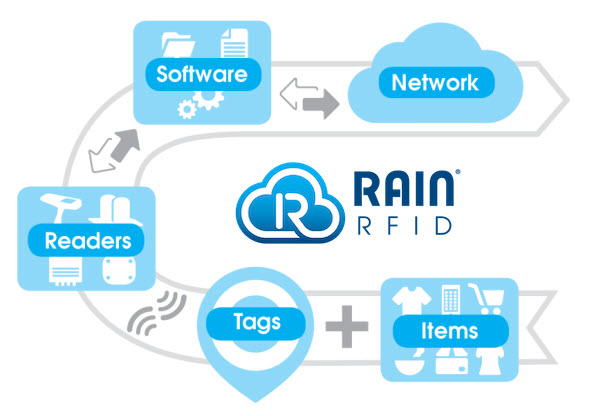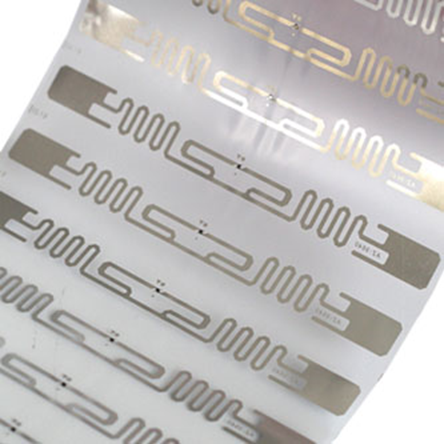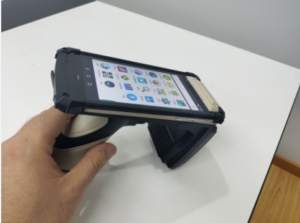What does RAIN have to do with RFID?
The term RAIN is derived from RAdio frequency IdentificatioN, also known as RFID. But, it is cloud-based infrastructure, where RFID data can be stored, managed, and shared via the Internet.
There are five common frequency ranges that RFID technology uses:
• Low-Frequency (125-134 KHz)
• High-Frequency and NFC (13.56 MHz)
• Active UHF (433 MHz)
• Passive UHF (860-960 MHz)
• Microwave (2.45-5.8 GHz)
RAIN is the brand name for Passive Ultra-High Frequency (UHF) RFID technology. It is an industry alliance to promote widespread use of Passive UHF RFID. The companies interested in this cause formed a RAIN Alliance.
Objective of RAIN Alliance
The RAIN Alliance wants to promote the widespread use of Passive Ultra-High Frequency (UHF) RFID technology so that the world becomes better connected.
What is the difference between Passive UHF RFID and RAIN?
 RAIN is not a product but an authority that certifies certain Passive UHF RFID based on their qualities. RFIDs that are RAIN certified are called RAIN RFID. While RFID technology has helped connecting day to day objects, RAIN technology connects the complete system through its RAIN Reader Communication Interface (RCI). The RCI guideline allows RFID Tags manufacturing companies to offer tags that could operate with any reader, thereby enabling deployments with multiple reader types, and offering a solution that could be used at multiple customer sites. As billions of tags are deployed on products and assets that might move through multiple RFID reader infrastructures, the guideline makes it easier for each application to identify tags of interest, and to automatically disregard those the system does not recognize. Only RAIN Alliance members can get their products RAIN certified.
RAIN is not a product but an authority that certifies certain Passive UHF RFID based on their qualities. RFIDs that are RAIN certified are called RAIN RFID. While RFID technology has helped connecting day to day objects, RAIN technology connects the complete system through its RAIN Reader Communication Interface (RCI). The RCI guideline allows RFID Tags manufacturing companies to offer tags that could operate with any reader, thereby enabling deployments with multiple reader types, and offering a solution that could be used at multiple customer sites. As billions of tags are deployed on products and assets that might move through multiple RFID reader infrastructures, the guideline makes it easier for each application to identify tags of interest, and to automatically disregard those the system does not recognize. Only RAIN Alliance members can get their products RAIN certified.
RAIN RFID solutions include three main elements:
Endpoints – Endpoints are products and their RAIN RFID tag chips that uniquely identifies the product.
Connectivity – A smart edge devices that enable wireless, bi-directional communication with endpoints.
Software – The software arranges and transforms data from endpoint reads, delivering real-time information to enterprise and consumer applications.
How Does RAIN Tags function?
RAIN tag is made from an integrated circuit (tag chip) and an antenna mounted on a substrate. Different companies offer variety of features in these tags like security, file management features, user memory, and the ability to add “battery assist”. These chips use wireless communication which means that they do not require ‘line- of- sight’. They have a capacity to scan up to 1,000 units/second.
How Does RAIN Reader function?
RAIN Readers are available in many different configurations. All RAIN readers can communicate with the RAIN tags and read and store their identity. Many readers can also write on the tag. There are two types of readers: fixed and portable(hand-held), and they come in many variations.
Fixed readers are mounted to a fixed location and can communicate with one to many antennas. They usually require a power supply and are connected to a network with an Ethernet cable.
Portable readers can be as small as to be configured in the mobile phones.
Advantages of RAIN RFID
RAIN RFID is used in many applications, including inventory management, asset tracking, and shipment verification. RAIN is the fastest growing segment of the RFID market and uses a single, global standard: UHF Gen 2 (ISO/IEC 18000-63).
• Minutely identifies an individual item beyond just its product type
• Identifies and locate items without direct line-of-sight
• Identifies up to 1,000 units per second
• Locate items within a range of a few centimeters to several meters
• Automates inventory and asset-tracking in healthcare, manufacturing, retail, and business sectors
• Locates the source of products, and enable timely recall of defective or dangerous items
• Facilitates tracking counterfeit products in the supply chain
• Improves shopping experiences for consumers, with fewer out-of-stock items and easier returns
• Increases supply chain visibility, resulting in a more efficient distribution channel and reduced business costs
• Decreases business revenue losses due to theft or inaccurate accounting of goods
RFIDHY is a leading distributer of RAIN RFID products. We adhere to the standards of RAIN Alliance and provide high quality tags/readers/antennas.






